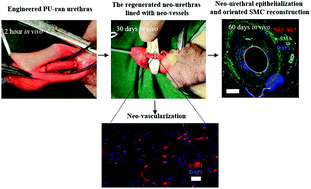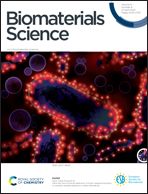Urethral reconstruction using an amphiphilic tissue-engineered autologous polyurethane nanofiber scaffold with rapid vascularization function†
Abstract
Reconstruction and functional rehabilitation of the long urethra in males is one of the difficult tasks in urological treatment. Although many kinds of tissue-engineered urethra scaffold grafts have been successfully used in animals and even clinical research of urethra reconstruction, they all have the disadvantages of slow vascularization in scaffolds, which may lead to complications such as stricture and blockage of the urethra. Here, an amphiphilic polyurethane tubular nanofiber scaffold with a hierarchical structure was designed as a urethral scaffold. The scaffold can regulate the phenotypic expression of epithelial cells (ECs) and smooth muscle cells (SMCs) in vitro and in vivo. Upon transplantation into the Beagle puppy's defective urethral site, the engineered PU-ran tubular scaffold graft, rich in seeded cell–matrix bio-interfaces, could induce local neo-vascularization in a controlled way, which facilitated lumen epithelialization and functional rehabilitation. This is favorable for urethral tissue-oriented reconstruction. These findings suggest the pivotal role of nano-topographical and biochemical features in the vascularized biomimetic scaffold design for efficacious urethral reconstruction.



 Please wait while we load your content...
Please wait while we load your content...